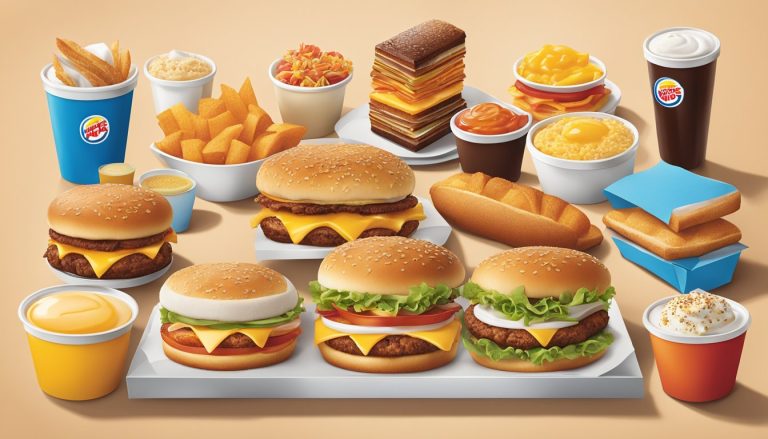Burger King’s fluffy eggs have become a breakfast staple for many fast-food enthusiasts. The secret behind their irresistible texture lies in the scientific principles of egg protein manipulation. By carefully controlling temperature and whisking techniques, BK creates scrambled eggs that are light, airy, and consistently delicious.
The process begins with fresh eggs at room temperature, allowing proteins to relax and incorporate air more easily during whisking. BK’s chefs then apply precise heat control, coagulating egg whites and yolks at their optimal temperatures to achieve the desired consistency. This attention to detail ensures that every bite of their breakfast menu item delivers a satisfying, cloud-like texture.
Fast-food chains like BK have perfected the art of mass-producing fluffy eggs, balancing efficiency with quality. Their method showcases how understanding food science can elevate even simple dishes. By applying these principles, BK has transformed a basic breakfast staple into a crave-worthy menu item that keeps customers coming back for more.
History and Evolution of Burger King Breakfast

Burger King‘s breakfast journey spans decades, from its humble beginnings to becoming a major player in the fast-food morning market. The company faced challenges and innovations as it developed its breakfast offerings.
Origins of Insta-Burger King
Insta-Burger King, founded in Jacksonville, Florida in 1953, utilized a novel cooking device called the Insta-Broiler. This machine quickly prepared burgers, giving the restaurant its name.
The original owners, Keith Kramer and his wife’s uncle Matthew Burns, aimed to capitalize on the growing fast-food trend. Their unique cooking method set them apart from competitors.
Transition to Burger King
In 1954, Miami-based franchisees James McLamore and David Edgerton acquired Insta-Burger King. They renamed it Burger King and replaced the Insta-Broiler with flame broilers.
This shift in cooking technology would later pose challenges for breakfast menu development. The flame broilers, while perfect for burgers, were not ideal for morning fare.
Breakfast Menu Inception and Changes
Burger King introduced its breakfast menu in 1979, responding to McDonald’s success in the morning market. However, the company struggled to adapt its flame broilers for breakfast items.
It took Burger King four years to create a viable breakfast menu. In 1983, they launched the Croissan’wich, their first major breakfast sandwich product.
Over time, Burger King expanded its breakfast offerings. They introduced various sandwiches, platters, and limited-time specials to attract morning customers.
Despite these efforts, Burger King has faced stiff competition. As of 2022, the chain was battling to maintain its position as the second-largest breakfast provider behind McDonald’s, with Wendy’s gaining ground.
Culinary Science of Egg Preparation

The culinary science behind egg preparation involves careful ingredient selection and precise cooking methods. These factors significantly impact the taste, texture, and nutritional value of the final product.
Freshness and Nutritional Value of Ingredients
Fresh eggs are essential for creating high-quality breakfast sandwiches. They contain more nutrients and produce better flavors compared to older eggs.
Eggs are packed with protein, vitamins, and minerals. A single large egg provides about 6 grams of protein and important nutrients like vitamin D, vitamin B12, and selenium.
For optimal freshness, eggs should be stored at temperatures below 40°F (4°C). Proper storage helps maintain their nutritional value and prevents bacterial growth.
Commercial kitchens often use pasteurized liquid eggs for convenience and food safety. These eggs undergo a heat treatment process that eliminates harmful bacteria while preserving most nutrients.
Cooking Techniques for Fluffy Texture
Achieving a fluffy egg texture requires specific cooking techniques. Low and slow cooking is key to creating soft, creamy scrambled eggs.
Cooking temperature plays a crucial role. Gentle heat (60-70°C/140-158°F) promotes slow protein denaturation, resulting in a tender texture.
Adding a small amount of liquid (milk or water) to eggs before cooking can enhance fluffiness. The added liquid creates steam during cooking, lifting the eggs and producing a softer texture.
Constant stirring while cooking helps distribute heat evenly and creates small, delicate curds. This technique contributes to a light, fluffy consistency.
Food-holding equipment maintains the temperature of cooked eggs without overcooking. A product monitoring system ensures eggs remain at safe temperatures throughout service.
Ingredients and Recipes in Focus

BK’s fluffy eggs form the foundation for a variety of breakfast sandwiches. Key ingredients like ham, bacon, sausage, and cheese complement the eggs to create signature menu items.
BK Signature Sandwiches and Eggs
The Croissan’wich stands out as one of BK’s most popular breakfast offerings. This sandwich features a flaky croissant filled with fluffy scrambled eggs and choice of meat.
The Enormous Omelet Sandwich lives up to its name with two fluffy egg patties. It’s stacked with sausage, bacon, and cheese on a sesame seed bun.
BK’s specialty breakfast sandwiches highlight the versatility of their egg preparation. Options range from classic bacon, egg and cheese to more elaborate combinations.
Role of Ham, Bacon, and Sausage
Meats play a crucial role in BK’s breakfast menu, adding savory flavor and protein. Ham provides a lean option with a mild, smoky taste. Bacon contributes a crispy texture and rich umami flavor.
Sausage patties offer a bolder, spicier profile. The meat’s fat content helps keep sandwiches moist.
BK often allows customization, letting customers choose their preferred meat or opt for a meatless version focused on the fluffy eggs.
Cheese and Other Toppings
American cheese is the standard choice for most BK breakfast sandwiches. Its meltability creates a creamy texture that pairs well with fluffy eggs.
Some specialty sandwiches feature other cheese varieties like cheddar or Swiss for a sharper flavor profile.
Additional toppings may include:
- Fresh vegetables (tomatoes, lettuce)
- Sauces (hollandaise, chipotle mayo)
- Hash browns for added crunch
These extras complement the eggs without overpowering their light, fluffy texture.
Food Innovation at Burger King

Burger King has consistently pushed the boundaries of fast food innovation, particularly in its breakfast offerings. The company has introduced creative menu items, partnered with popular brands, and refined its testing processes to stay competitive.
Collaborations with Brands
Burger King has teamed up with well-known brands to create unique menu items. One notable collaboration was with Pillsbury, resulting in the iconic Croissan’wich. This breakfast sandwich combines a flaky croissant with savory fillings.
The partnership leveraged Pillsbury’s expertise in baked goods to elevate Burger King’s breakfast menu. This strategy has helped BK differentiate itself from competitors and attract new customers.
Introduction of Specialty Items
Burger King has introduced several specialty items to cater to changing consumer preferences. The Impossible Whopper, a plant-based alternative to the classic Whopper, showcases BK’s commitment to innovation.
For breakfast, the Enormous Omelet Sandwich made waves with its hefty portion size. BK has also added healthier options like breakfast bowls and burritos to appeal to health-conscious diners.
These limited-time offerings (LTOs) keep the menu fresh and generate buzz among customers.
Testing and Launching New Breakfast Options
Burger King’s innovation process involves rigorous testing before menu items reach franchises nationwide. The company’s culinary team develops new concepts in test kitchens, focusing on flavor profiles and ingredient combinations.
Promising items undergo market testing in select locations to gauge customer response. Successful options, like the Egg-normous Breakfast Burrito, are then rolled out across the franchise network.
This methodical approach helps Burger King minimize risks associated with new product launches while ensuring menu items meet customer expectations.
Nutritional Aspects of BK’s Breakfast Menu
Burger King’s breakfast menu offers a range of options with varying nutritional profiles. The caloric content and balance of nutrients differ across menu items, providing choices for different dietary needs and preferences.
Assessment of Caloric Content
Burger King’s breakfast items span a wide caloric range. The Egg-normous Burrito contains 1061 calories, making it one of the highest-calorie options. In contrast, a single hash brown provides 150 calories. Breakfast sandwiches typically fall between 300-700 calories.
The Double Croissan’wich with sausage and bacon packs about 700 calories. This sandwich combines multiple protein sources with a buttery croissant. For a lighter option, the Ham, Egg & Cheese Biscuit offers 370 calories.
BK’s Ultimate Breakfast Platter represents a more substantial meal choice. It includes various breakfast staples, resulting in a higher calorie count.
Offering Balanced Meal Options
Burger King aims to provide some balance in its breakfast menu. The Egg-normous Burrito, despite its high calorie count, offers 15g of protein and 27g of carbohydrates. This combination can contribute to feelings of fullness.
Some menu items include vegetables, adding nutritional value. The breakfast burrito, for example, incorporates peppers and onions. These ingredients boost fiber content and provide essential vitamins.
BK’s breakfast sandwiches often pair protein-rich eggs with cheese, offering calcium and additional protein. However, sodium content can be high in many items, exceeding daily recommendations in some cases.
For those seeking lower-calorie options, BK offers alternatives like the mini pancakes at 230 calories per serving. These can be paired with other items to create a more balanced meal.
Impact of Advertising on Consumer Preferences
Advertising plays a crucial role in shaping consumer preferences for fast food brands like Burger King. It influences perceptions, attitudes, and purchasing decisions through targeted campaigns and strategic marketing efforts.
Historical Advertising Campaigns
Burger King’s iconic “Have It Your Way” slogan, introduced in the 1970s, revolutionized fast food advertising. This campaign emphasized customization, setting BK apart from competitors.
In the 1980s, the “Whopper Beat Big Mac” ads directly challenged McDonald’s, sparking the “Burger Wars.” These comparative ads boosted BK’s market share.
The 2004 “Subservient Chicken” viral campaign broke new ground in interactive marketing. It allowed users to give commands to a person in a chicken costume, generating massive online engagement.
Modern Marketing Strategies
Social media now plays a central role in BK’s advertising efforts. The brand leverages platforms like Twitter and Instagram to create buzz and connect with younger consumers.
BK’s recent “Moldy Whopper” campaign showcased a time-lapse of a decomposing burger. This bold approach highlighted the absence of artificial preservatives, appealing to health-conscious consumers.
Augmented reality promotions, like the “Burn That Ad” campaign, encourage mobile app usage. Customers can virtually “burn” competitors’ ads to receive free Whoppers.
Cultural Influence on Menu Creation
Advertising helps BK introduce culturally-inspired menu items. The “Proud Whopper” campaign promoted inclusivity during Pride month, featuring rainbow-wrapped burgers.
In India, BK’s ads highlight vegetarian options like the Veggie Whopper. This strategy caters to local dietary preferences and religious considerations.
Limited-time offers, such as the “Halloween Whopper” with black buns, generate excitement through targeted advertising. These promotions often incorporate seasonal and pop culture themes.
BK’s Global Reach and Diverse Offerings

Burger King’s international presence spans 90 countries, offering localized menu items alongside classic favorites like the Whopper. This global footprint allows BK to cater to diverse tastes while maintaining its core identity as an American fast-food giant.
Franchise Growth and Locations
Burger King boasts over 18,000 restaurants worldwide, rivaling other major fast-food chains in terms of global reach. The company’s franchise model has fueled rapid expansion across continents. BK serves U.S. troops at overseas bases, bringing a taste of home to military personnel.
In recent years, Burger King’s parent company announced plans to increase global locations by 55%. This ambitious growth strategy aims to solidify BK’s position as one of the world’s largest restaurant chains. The focus on international markets has led to fresh restaurant designs and improved digital strategies in many countries.
Local Variations and Regional Specialties
Burger King adapts its menu to suit local tastes and preferences in different countries. This strategy has resulted in unique offerings that reflect regional culinary traditions.
In Japan, BK introduced black-bunned Whoppers, a striking variation on the classic burger. The Canadian Whopper features bacon and mayonnaise, catering to local preferences. Some international locations offer rice dishes alongside traditional hamburgers.
The Teriyaki Whopper, popular in several Asian markets, combines familiar BK flavors with local ingredients. These regional specialties help Burger King compete with local chains and other international fast-food giants like McDonald’s.
BK’s willingness to experiment with flavors and ingredients in different markets has enhanced its appeal to diverse customer bases. This approach allows the chain to maintain its core identity while embracing local food cultures.
The Future of Breakfast at Burger King

Burger King is poised to transform its breakfast offerings through menu innovation and health-focused options. The fast food giant aims to adapt to changing consumer preferences while maintaining its signature flame-grilled taste.
Innovation and Consumer Trends
Burger King plans to expand its breakfast hours to capture more of the morning market. The chain is exploring new flavor combinations for its popular Croissan’Wich lineup.
Plant-based alternatives are likely to feature prominently on future menus. Burger King has already seen success with plant-based options in other dayparts.
Digital ordering and delivery services will play a larger role in breakfast sales. The company is investing in technology to streamline the morning rush experience.
Value will remain a key focus. Burger King may introduce more competitive breakfast deals to rival competitors like Wendy’s and McDonald’s.
Health-Conscious Menu Development
Burger King is expected to introduce more egg white options for health-conscious consumers. The chain may also reduce sodium and artificial ingredients in existing breakfast items.
Whole grain alternatives could appear alongside traditional biscuits and croissants. Oatmeal and yogurt parfaits may join the menu as lighter choices.
Fresh fruit additions are likely to become more prevalent. These could be offered as sides or incorporated into new sandwich creations.
Portion control options may expand, allowing customers to customize their breakfast size. This approach caters to various dietary needs while maintaining broad appeal.




